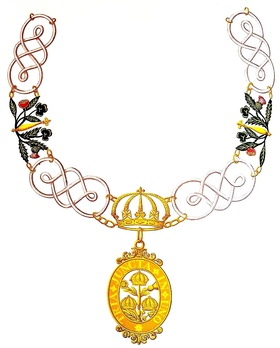The Most Honourable Order of the Bath, Type II, Civilian Division, Collar
CATEGORY: Version
SKU: 01.GBR.0104.105.01.000
Estimated market value:

Estimated market value:
The Most Honourable Order of the Bath was established by King George I in 1725 on the advice of the first Prime Minister of the United Kingdom, Sir Robert Walpole. His proposal was a politically motivated effort to limit the number of members of the Order of the Garter and secure a source of political favours.
The Order derives its name from the ceremonial bath that Knights performed as part of a series of purification rites before they were admitted into knighthood during the medieval era. These rites were continued as part of the tradition until 1815 when the Order was entirely restructured. It has since been the members themselves who have invested the Order with its prestige, and not its thinly veiled connections to traditions of the past.
Membership was originally limited to 36 Knight Companions, but participation in the Napoleonic Wars necessitated an increase in membership to reward military achievement. In 1815, the Order was expanded from a single class into a three-class system with a military and civil division, although the civil division was not formalized until 1847.
The Order is currently conferred by the Prime Minister of the United Kingdom upon citizens of the Commonwealth in recognition of meritorious military and civil service. Since 1971, both men and women are eligible to be admitted into the Order. Members of the British Royal Family and foreigners may also be admitted to the Order, but they are not counted towards the statutory limits of Knights and Dames. Membership is currently limited to 120 Knights or Dames Grand Cross, 355 Knights or Dames Commander, and 1925 Companions.
Members of the first class are entitled to use the post-nominal letters GCB, members of the second class are entitled to use the post-nominal letters KCB or DCB, and Companions are entitled to use the post-nominal letters CB. Members of the first and second classes are also entitled to use the formal title “Knight” or “Dame.”
The civil division uses the motto “TRIA JUNCTA IN UNO,” (“Three joined in one”) which was the original motto of the Order prior to its reorganization.
The Type II Collar is worn by Knights and Dames Grand Cross on formal occasions along with a mantle. It is composed of alternating links of 9 imperial crowns, 8 spectres surrounded of roses, thistles and shamrocks, and 17 knots. The badge appendant differs according to the division of the member.
The Collar must be returned to the Central Chancery of the Orders of Knighthood following the death of the recipient.
There may be additional versions that differ in size, manufacturer, or composition.

Comments
Sign in to comment and reply.


Scroll Top